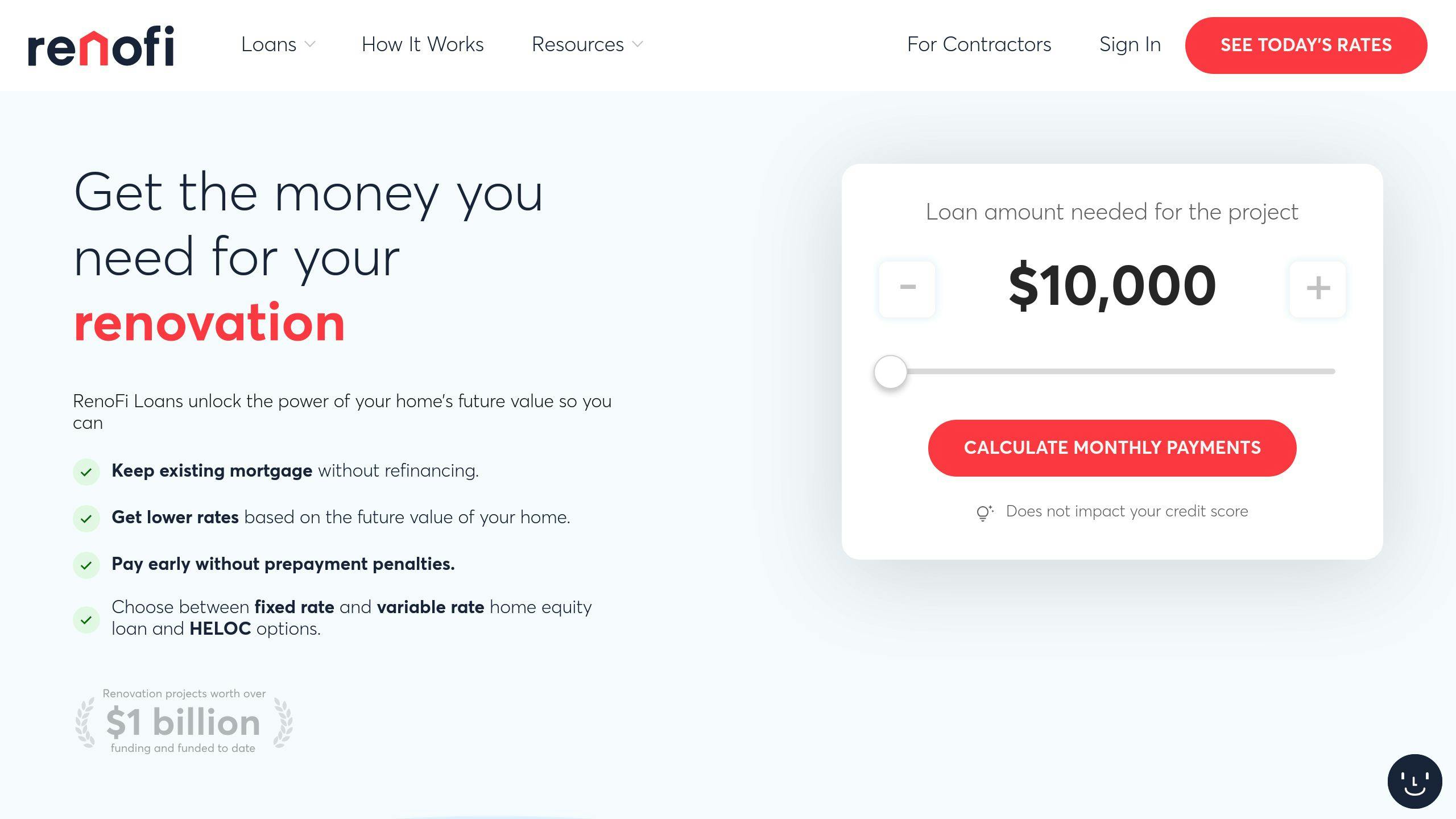Looking to build an ADU in 2024? Here's a quick rundown of your financing options:
- Bank loans: HELOCs, home equity loans, cash-out refinancing
- Government help: CalHFA ADU Grant Program (up to $40k for planning)
- Special loans: Freddie Mac's Choice Renovation Mortgage (3% down for first-timers)
- FHA changes: Now counts 75% of expected ADU rent for loan qualification
Key points:
- ADU costs range from $75k-$400k depending on type
- 56% of California ADU builders use home equity loans or HELOCs
- Government grants are available but competitive
- New FHA rules make it easier to finance ADUs
Before choosing:
- Check your equity and credit score
- Nail down your ADU budget
- Decide if it's for family or rental
- Compare rates from different lenders
Remember: The best option depends on your finances and long-term plans for the ADU.
Related video from YouTube
Bank Loans and Mortgages
Financing your ADU in 2024? Let's talk about bank loans and mortgages. They're still top picks for many homeowners.
Home Equity Loans and HELOCs
Got equity? You're in business. Home equity loans and HELOCs are popular choices. In fact, 56% of California ADU builders used one of these options, according to a Terner Center report.
What's the difference?
- Home equity loans: One-time lump sum, fixed payments
- HELOCs: Like a credit card, borrow as needed
Both use your home as collateral, so you'll typically see lower interest rates than unsecured loans.
Cash-Out Refinancing
This is about swapping your current mortgage for a bigger one. You get the difference in cash for your ADU project. It's a solid bet if you've got $200,000+ in equity.
Construction Loans
These are built for building. They cover construction costs with interest-only payments during the build. Once your ADU is done, they often turn into a regular mortgage.
"Construction loans are great for homeowners without much equity or those tackling pricier projects than their available equity allows." - Prosper Marketplace, Inc.
RenoFi Loans
New kid on the block, RenoFi loans let you borrow based on your home's future value post-ADU. This can boost your borrowing power by up to 3x compared to traditional options.
Justin Goldman, RenoFi's Co-Founder and CEO, puts it this way:
"Recent homebuyers often hit a wall. It can take 10+ years to build the equity needed for their renovation wishlist."
DSCR Loans
Planning to rent out your ADU? Look into Debt Service Coverage Ratio (DSCR) loans. They focus on potential rental income, not your personal income. It's a smart play if you're maxed out on traditional borrowing.
With ADU costs in California averaging around $150,000, choosing the right financing is key. Before you jump in:
- Check your equity and credit score
- Nail down your ADU budget and timeline
- Think about how you'll use the ADU (family or rental?)
- Compare rates and terms from different lenders
The best choice? It depends on your finances, credit, and long-term ADU plans. Do your homework and pick the option that fits you best.
2. Federal and State Programs
In 2024, government support for ADU construction has grown. Let's look at some key federal and state programs that can help fund your ADU project.
FHA's New ADU Policy
The Federal Housing Administration (FHA) has made a big change. Since October 16, 2023, lenders can now count ADU rental income when underwriting FHA loans. This is great news for homeowners wanting to build or buy properties with ADUs.
Here's how it works:
- Existing ADUs: Lenders can use 75% of estimated rental income to qualify borrowers.
- New ADUs: 50% of projected rental income can be used under the FHA's 203(k) Rehabilitation Mortgage program.
"The new guidelines are part of the Biden-Harris Administration's Housing Supply Action Plan, which aims to increase access to homeownership by addressing affordable housing challenges." - The Truth About Mortgage
But there's a catch: ADU rental income can't be more than 30% of your total monthly income used for loan qualification. You'll also need to show two months of reserves (PITI) to qualify.
California's ADU Grant Program
California's ADU Grant Program, run by CalHFA, offers up to $40,000 to low-income homeowners for predevelopment and non-recurring closing costs.
This covers things like site prep, architectural designs, permits, soil tests, impact fees, property surveys, and energy reports. It's perfect for those early ADU expenses that often surprise homeowners.
To qualify, your income needs to be less than 80% of the Area Median Income (AMI). For example, in San Diego, a family of four would need to earn less than $93,440 to be eligible.
State-Specific Initiatives
Other states are also offering support:
- San Diego Housing Commission ADU Finance Program: Offers loans just for ADU construction in San Diego.
- Local Early Action Planning (LEAP) Grants: Gives funding to local governments for housing-related projects, including ADU initiatives.
- Community Development Block Grant Program (CDBG): While not just for ADUs, this federal program can sometimes be used for housing projects, including ADUs in some areas.
The Fine Print
These programs are popular and funds go fast. For example, Phase 2 of California's ADU Grant Program, launched on December 11, 2023, was fully allocated by December 28, 2023.
The lesson? Be quick and stay informed. Check your state's housing authority website often for updates on ADU financing programs. They can change quickly, and funds often run out fast.
sbb-itb-4e754d1
3. Other Ways to Fund Your ADU
Bank loans and government programs aren't your only options for ADU financing in 2024. Let's look at some creative alternatives that might work for you.
Home Equity Investments (HEIs)
HEIs offer a debt-free way to fund your ADU. Companies like Point, Hometap, and Unison let you tap up to 25% of your home's equity without monthly payments. Here's the deal:
- You get a lump sum
- The investor gets a slice of your home's future value increase
- No monthly payments
- You pay back when you sell, refinance, or at the end of the term (usually 10-30 years)
"HEIs are a smart, debt-free way to finance an ADU that many homeowners are using", says Erin, a real estate expert.
Rent-Sharing Loans (RSLs)
RSLs are catching on in ADU financing. They offer flexible payback options and can put off payments for up to two years. The catch? You'll split some of your ADU's rent with the lender.
Cash-Out Refinancing
Got a lot of equity in your home? Cash-out refinancing might work. Here's how it could look:
- Your home's worth $300,000
- You owe $120,000 on your mortgage
- You could borrow up to $240,000 (80% of your home's value)
- That leaves $120,000 for your ADU
Just remember, this replaces your current mortgage with a bigger one. Think about interest rates and closing costs (2% to 5% of the loan).
Construction-to-Permanent Loans
These loans are made for building projects like ADUs. They work in two steps:
1. Building phase: You get money as you need it during construction, paying interest only on what you use.
2. Permanent phase: After building, the loan turns into a regular mortgage.
This can be great if you don't have enough equity for a cash-out refinance or HELOC.
Private Money Lending
If you have a non-owner occupied property or a unique situation, private money lending can be more flexible than traditional loans. These loans, including bridge loans, often look at the total project cost instead of your home equity.
When you're thinking about these different funding options, make sure to weigh the pros and cons carefully. Each one has its own terms, costs, and potential risks. Talk to a financial advisor to figure out which option fits best with your long-term money goals and ADU plans.
Benefits and Drawbacks
Let's dive into the pros and cons of popular ADU financing options for 2024:
Home Equity Loans and HELOCs
Home equity loans and HELOCs can be great options, but they come with some risks:
Pros:
- Lower interest rates than unsecured loans
- Possible tax deductions on interest
- Access to substantial funds based on your equity
Cons:
- Your home's at risk if you can't make payments
- You'll need 15-20% equity to qualify
- HELOC rates can go up over time
"HELOCs give you flexible access to funds, while home equity loans offer steady payments. Pick based on your project needs and finances." - Richard Garrett, ADU Expert
Cash-Out Refinancing
Cash-out refinancing can be a solid choice, but it's not for everyone:
Pros:
- Often has lower rates than other options
- One loan to repay
- You get a lump sum for your ADU
Cons:
- Closing costs can be 2-5% of the loan
- Extends your mortgage term
- Limited to 80% of your home's value
Construction Loans
Construction loans are based on your future home value, which has its upsides and downsides:
Pros:
- Can work even if you don't have much equity
- You only pay interest during construction
- Based on your home's future value
Cons:
- Tough application process
- Higher rates than regular mortgages
- Turns into a regular mortgage after construction
Government Grants and Programs
Free money sounds great, but it's not always easy to get:
Pros:
- You don't have to pay it back
- Can cover a big chunk of early costs
- Supports affordable housing
Cons:
- Hard to get and lots of competition
- Strict rules on who can apply
- Might not cover everything
"Grants can make your ADU cheaper, but check if you qualify first." - EHD Builders
RenoFi Renovation Loans

RenoFi loans offer some unique benefits, but they're not perfect:
Pros:
- Borrow based on future home value
- Can boost your borrowing power by 3x
- Keeps your primary mortgage as-is
Cons:
- Rates might be higher than some traditional loans
- You need good credit and income
- Not available everywhere
Home Equity Investments (HEIs)
HEIs are a different approach, with some interesting trade-offs:
Pros:
- No monthly payments
- Doesn't add to your debt
- Quick approval
Cons:
- You give up some future home value
- Investors might need to approve your plans
- Can cost more if your home value jumps
When picking a financing option, think about your current money situation, long-term plans, and what your ADU project needs. Each option has its strengths and weaknesses, so weigh them carefully against what works for you.
Conclusion
Picking the right financing for your ADU project in 2024 can make or break your success. Here's what you need to know:
First, take a hard look at your finances. Your home equity, credit score, and income stability will shape your options.
Grants should be your first stop. The California Housing Finance Agency offers up to $40,000 for pre-development costs. It's free money if you qualify.
If grants aren't enough, loans are your next best bet:
- Home equity loans and HELOCs are popular. 56% of California ADU builders use them.
- Cash-out refinancing works if you've got lots of equity.
- Construction loans are good for those with solid credit but less equity.
- RenoFi Renovation Loans can boost your borrowing power based on future home value.
Mix and match for best results. Use grants for planning and permits, then loans for building.
Think long-term. How will you use the ADU? Family housing? Rental income? Extra living space? Your plans will affect your financing choice.
Be realistic about costs. Garage conversions run $90,000 to $130,000. Detached units? $180,000 to $275,000. Studios hover around $100,000, while 2-bedroom ADUs hit about $200,000. Always budget extra for surprises.
Richard Garrett from RG ProBuilders says:
"At RG ProBuilders, we understand that starting on an ADU project is more than just a construction task - it's a journey toward enhancing your living space and financial stability."
Consider talking to ADU financing experts. They can give you personalized advice based on your situation.
FAQs
What type of loan is best for ADU?
Home Equity Loans often top the list for ADU financing. Why? They let you tap into your home's equity above your first mortgage.
Here's why they're popular:
- Lower interest rates than unsecured loans
- Potential tax benefits (check with a tax pro)
- You get all the money upfront
But remember, the best loan depends on your situation. If you're a new homeowner without much equity, you might want to look at construction loans or RenoFi Renovation Loans instead.
"Recent homebuyers can't easily tap into their home equity for renovations. It can take years to build up enough." - Justin Goldman, RenoFi Co-Founder and CEO
What is the ADU grant program?
The CalHFA ADU Grant Program helps California homeowners build ADUs. Here's the scoop:
- Up to $40,000 grant
- Covers pre-development and non-recurring closing costs
- Pays for things like site prep, designs, permits, and impact fees
The program launched in 2021 with $100 million, spread across 44 California counties. 42% of the funds went to socially disadvantaged areas.
To qualify, you need to:
- Own and live in the home where you'll build the ADU
- Have a household income at or below 80% of your area's median
- Own a single-family home zoned for ADUs
- Have no outstanding liens or judgments on your property
"The ADU Grant Program helps homeowners invest in their property and address California's housing needs." - CalHFA
Heads up: As of early 2024, the program's on pause due to lack of funds. Keep an eye on CalHFA's website for updates.
What new federal policy allows you to finance an ADU?
On October 16, 2023, the FHA announced a game-changing policy for ADU financing. It's part of the Biden-Harris Administration's push for more housing and homeownership.
Here's what's new:
- Lenders can now use some ADU rental income to qualify borrowers for FHA-insured mortgages.
- For existing ADUs, up to 75% of estimated rental income counts.
- For new ADUs under the FHA's 203(k) Rehabilitation Mortgage program, 50% of projected rental income counts.
- ADU rental income can't be more than 30% of the total monthly income used for the loan.
- Borrowers need to show two months of reserves (PITI) to qualify.
"This new FHA policy opens up more financing options for homes with ADUs. It's a big step towards the Biden-Harris Administration's housing and homeownership goals." - Bill Lyons, Griffin Funding Founder, CEO & President
This change makes it easier to finance ADU construction or buy homes with ADUs, potentially boosting affordable housing options in many areas.


